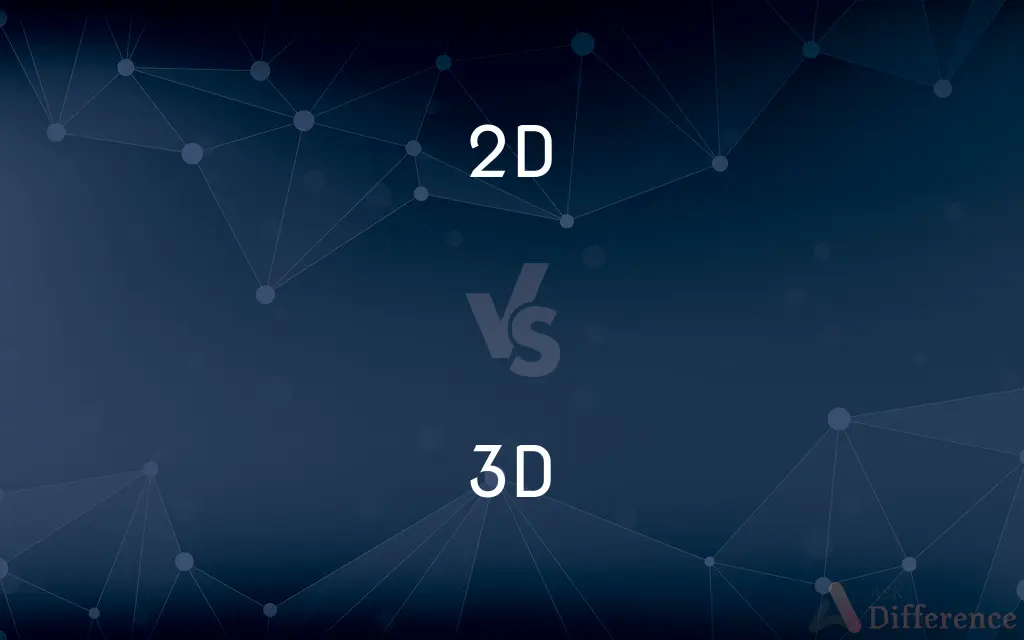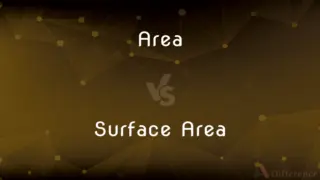2D vs. 3D — What's the Difference?
Edited by Tayyaba Rehman — By Fiza Rafique — Published on November 5, 2023
2D represents two-dimensional, flat objects with length and width. 3D represents three-dimensional objects with length, width, and depth.

Difference Between 2D and 3D
Table of Contents
ADVERTISEMENT
Key Differences
2D, or two-dimensional, refers to objects or images that have two dimensions: length and width. These objects or images exist on a flat plane and lack depth. 2D representations can be seen in drawings, paintings, or even flat-screen displays where characters and objects don't exhibit depth or volume.
3D, or three-dimensional, pertains to objects or images that possess three dimensions: length, width, and depth. These objects or images showcase volume and can be observed from various perspectives. 3D can be associated with sculptures, real-world objects, and even films or video games that offer a depth perspective, giving the viewer an illusion of three-dimensional space.
2D drawings or designs are typically easier and faster to create as they require fewer details and perspectives. They are commonly used in graphics, architectural plans, or cartoons where depth perception is not mandatory. On the other hand, 3D models or designs, while more intricate and time-consuming, offer a fuller representation of the subject, which is crucial in fields such as animation, engineering, or virtual reality.
2D images can sometimes be limiting because they present a single viewpoint. This can be seen in photographs or sketches. 3D models, however, allow for rotations and explorations from multiple angles, providing a more holistic view. For instance, in a video game, a 3D environment lets players navigate around objects, while in a 2D game, movement is typically more restricted.
In modern technology, 2D graphics are still widely used in various applications, especially where depth is not essential. 3D graphics, conversely, have seen a surge in popularity and application, from film-making to 3D printing, offering more dynamic and immersive experiences.
ADVERTISEMENT
Comparison Chart
Dimensions
Two dimensions: Length and Width.
Three dimensions: Length, Width, and Depth.
Representation
Flat and lacks depth.
Shows volume and can be viewed from multiple angles.
Usage
Graphics, drawings, flat-screen displays.
Animation, sculptures, virtual reality, video games.
Perspective
Single viewpoint; objects appear flat.
Multiple viewpoints; objects exhibit depth and volume.
Complexity
Typically simpler and quicker to design.
More intricate and time-consuming due to added dimension.
Compare with Definitions
2D
A flat image without perceived depth.
Most traditional cartoons are presented in 2D format.
3D
Relating to objects, designs, or visuals that show depth.
With the advent of technology, 3D movies have gained immense popularity.
2D
Lacking volume and only existing on a plane.
The architect's initial sketches were 2D before developing them into 3D models.
3D
Denoting a fuller, more holistic view of subjects.
The architect used a 3D printer to bring her designs to life.
2D
Representing visuals that only capture length and width.
Despite being a 2D image, the photograph captured the essence beautifully.
3D
Exhibiting volume and existing in spatial form.
Modern video games are mostly developed in 3D to offer a more immersive experience.
2D
Relating to objects or designs that don't exhibit depth.
Graphic designers often begin with 2D mockups before moving to more complex designs.
3D
Pertaining to three dimensions: length, width, and depth.
The sculpture was a 3D representation of the artist's vision.
2D
Pertaining to two dimensions, namely length and width.
The painting was a 2D representation of the landscape.
3D
Representing real-world objects that can be observed from various perspectives.
The virtual tour provided a 3D view of the historical monument.
2D
Abbreviation of two-dimensional; 2D.
3D
Three-dimensional.
2D
Obsolete form of 2nd
3D
A three-dimensional medium, display, or performance, especially a cinematic or graphic medium in three dimensions
They shot the movie in 3D.
2D
Abbreviation of two [[penny(in pre-decimalisation currency, never used for 'two new pence').
3D
Abbreviation of three-dimensional
2D
Coming next after the first in position in space or time or degree or magnitude
3D
Thruppence, threepence, a coin valuing three pennies
2D
Coming next after the first in position in space or time or degree or magnitude
3D
A movie with images having three dimensional form or appearance
3D
Having a three-dimensional form or appearance;
Aren't dreams always in 3-D?
Common Curiosities
Are photographs typically 2D or 3D?
Photographs are typically 2D as they present a flat image without depth.
Why are 2D graphics still used in some video games?
2D graphics often require fewer resources, provide a distinct aesthetic, and are preferred for certain game genres for gameplay simplicity.
What does 3D stand for?
Three-dimensional, representing length, width, and depth.
What does 2D stand for?
Two-dimensional, indicating length and width.
Can 3D objects be converted into 2D representations?
Yes, 3D objects can be projected or flattened into 2D representations, commonly seen in blueprints or diagrams.
Why do 2D animations often seem "flatter" than 3D?
Because 2D animations exist in two dimensions without depth, making characters and scenes appear flat or without volume.
Are all computer graphics 3D nowadays?
No, many computer graphics, especially for websites, ads, and some video games, are still created in 2D for stylistic or resource reasons.
How do 3D movies provide a depth perception?
3D movies use two slightly offset images displayed simultaneously, and with special glasses, each eye sees one image, creating an illusion of depth.
Can 2D images be converted to 3D?
With specialized software and techniques, 2D images can be given depth and converted into a 3D-like representation, though it's an approximation.
Is there a difference between "3D sound" and visuals being 3D?
Yes, 3D sound refers to audio engineered to come from multiple directions, creating a spatial sound experience, while visuals being 3D relate to depth perception in imagery.
How are 3D images created in computers?
3D images are modeled using specialized software, setting points in three-dimensional space, and then rendering them to produce a 3D appearance.
Is there a difference between 3D films and 3D animations?
Yes, 3D films capture real-life objects in three dimensions, while 3D animations are digitally created representations of three-dimensional objects.
Why are glasses often needed to view 3D movies or TVs?
Glasses help filter separate images to each eye, creating the illusion of depth and making the imagery appear three-dimensional.
Are 2D and 3D the only dimensional representations in media?
While 2D and 3D are the most common, there's also mention of "4D" in some contexts, typically referring to 3D with added time or sensory elements, like physical effects in theaters.
How does 3D printing work?
3D printing builds objects layer by layer, using various materials, based on a digital 3D model.
Share Your Discovery

Previous Comparison
Area vs. Surface Area
Next Comparison
Premium Economy vs. Business ClassAuthor Spotlight
Written by
Fiza RafiqueFiza Rafique is a skilled content writer at AskDifference.com, where she meticulously refines and enhances written pieces. Drawing from her vast editorial expertise, Fiza ensures clarity, accuracy, and precision in every article. Passionate about language, she continually seeks to elevate the quality of content for readers worldwide.
Edited by
Tayyaba RehmanTayyaba Rehman is a distinguished writer, currently serving as a primary contributor to askdifference.com. As a researcher in semantics and etymology, Tayyaba's passion for the complexity of languages and their distinctions has found a perfect home on the platform. Tayyaba delves into the intricacies of language, distinguishing between commonly confused words and phrases, thereby providing clarity for readers worldwide.













































